Human Resource Management Report: HR Functions & Management
VerifiedAdded on 2020/05/11
|8
|1568
|55
Report
AI Summary
This report examines critical components of Human Resource Management (HRM), emphasizing the shift towards strategic HRM where HR aligns with organizational goals. It addresses employee termination, highlighting legal considerations and best practices, alongside the costs associated with employee turnover, including termination, resignation, promotion, or death. The report explores the importance of job satisfaction and its relationship to productivity, using examples like FedEx. It also covers the necessity of meticulous human resources record keeping, detailing legal requirements and its role in protecting the organization. Finally, the report underscores why all managers need to understand HRM, given its evolution into a strategic function vital for operational efficiency and decision-making.
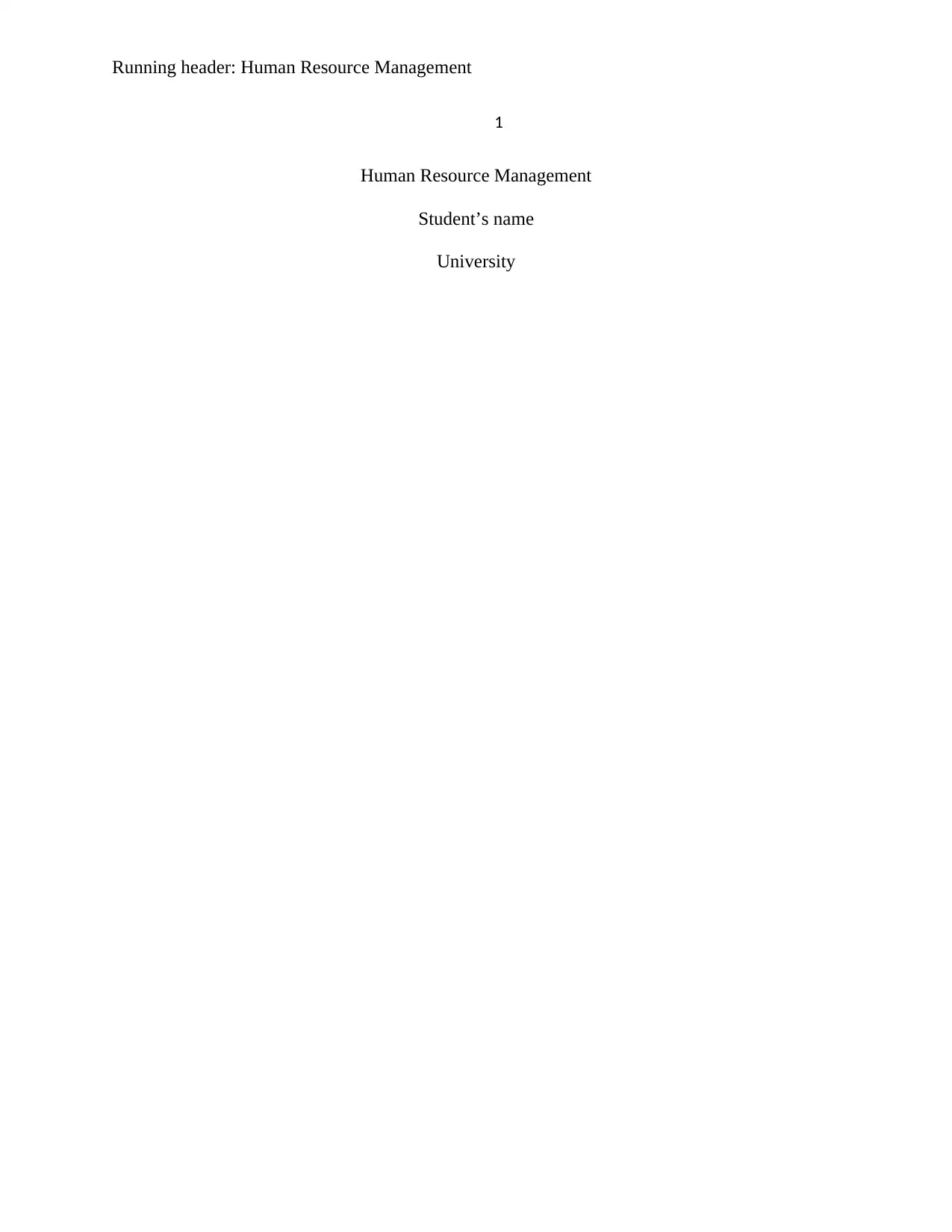
Running header: Human Resource Management
1
Human Resource Management
Student’s name
University
1
Human Resource Management
Student’s name
University
Paraphrase This Document
Need a fresh take? Get an instant paraphrase of this document with our AI Paraphraser
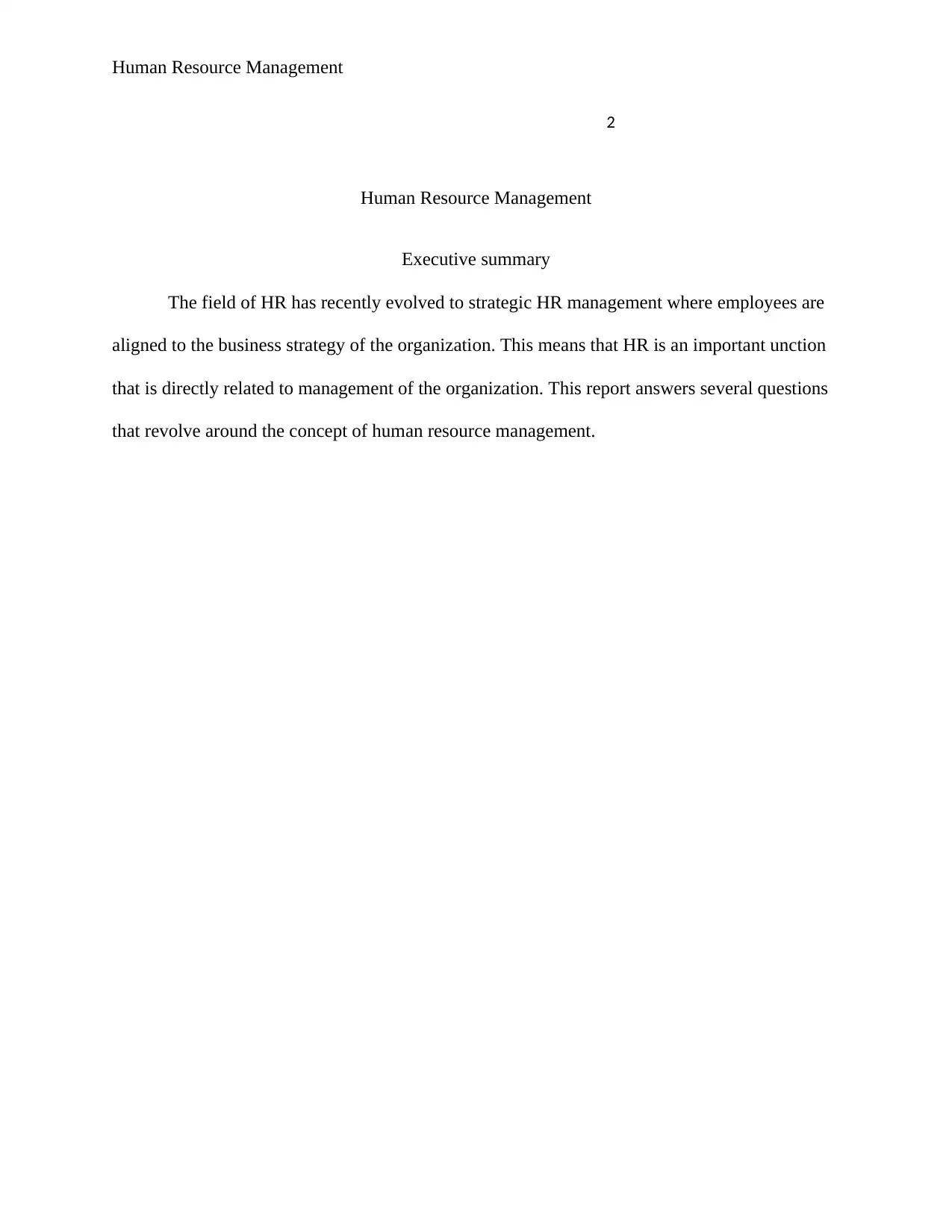
Human Resource Management
2
Human Resource Management
Executive summary
The field of HR has recently evolved to strategic HR management where employees are
aligned to the business strategy of the organization. This means that HR is an important unction
that is directly related to management of the organization. This report answers several questions
that revolve around the concept of human resource management.
2
Human Resource Management
Executive summary
The field of HR has recently evolved to strategic HR management where employees are
aligned to the business strategy of the organization. This means that HR is an important unction
that is directly related to management of the organization. This report answers several questions
that revolve around the concept of human resource management.
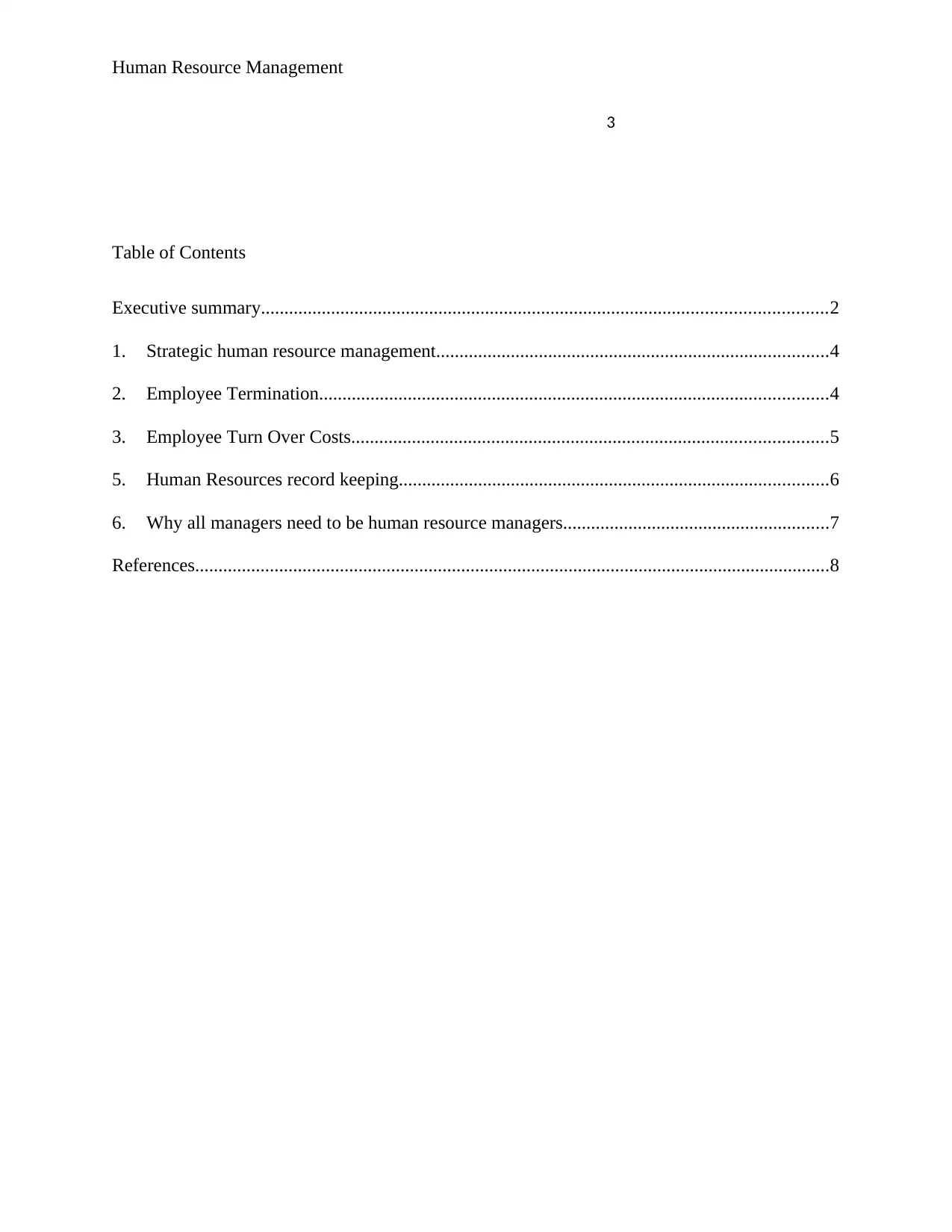
Human Resource Management
3
Table of Contents
Executive summary.........................................................................................................................2
1. Strategic human resource management....................................................................................4
2. Employee Termination.............................................................................................................4
3. Employee Turn Over Costs......................................................................................................5
5. Human Resources record keeping............................................................................................6
6. Why all managers need to be human resource managers.........................................................7
References........................................................................................................................................8
3
Table of Contents
Executive summary.........................................................................................................................2
1. Strategic human resource management....................................................................................4
2. Employee Termination.............................................................................................................4
3. Employee Turn Over Costs......................................................................................................5
5. Human Resources record keeping............................................................................................6
6. Why all managers need to be human resource managers.........................................................7
References........................................................................................................................................8
⊘ This is a preview!⊘
Do you want full access?
Subscribe today to unlock all pages.

Trusted by 1+ million students worldwide
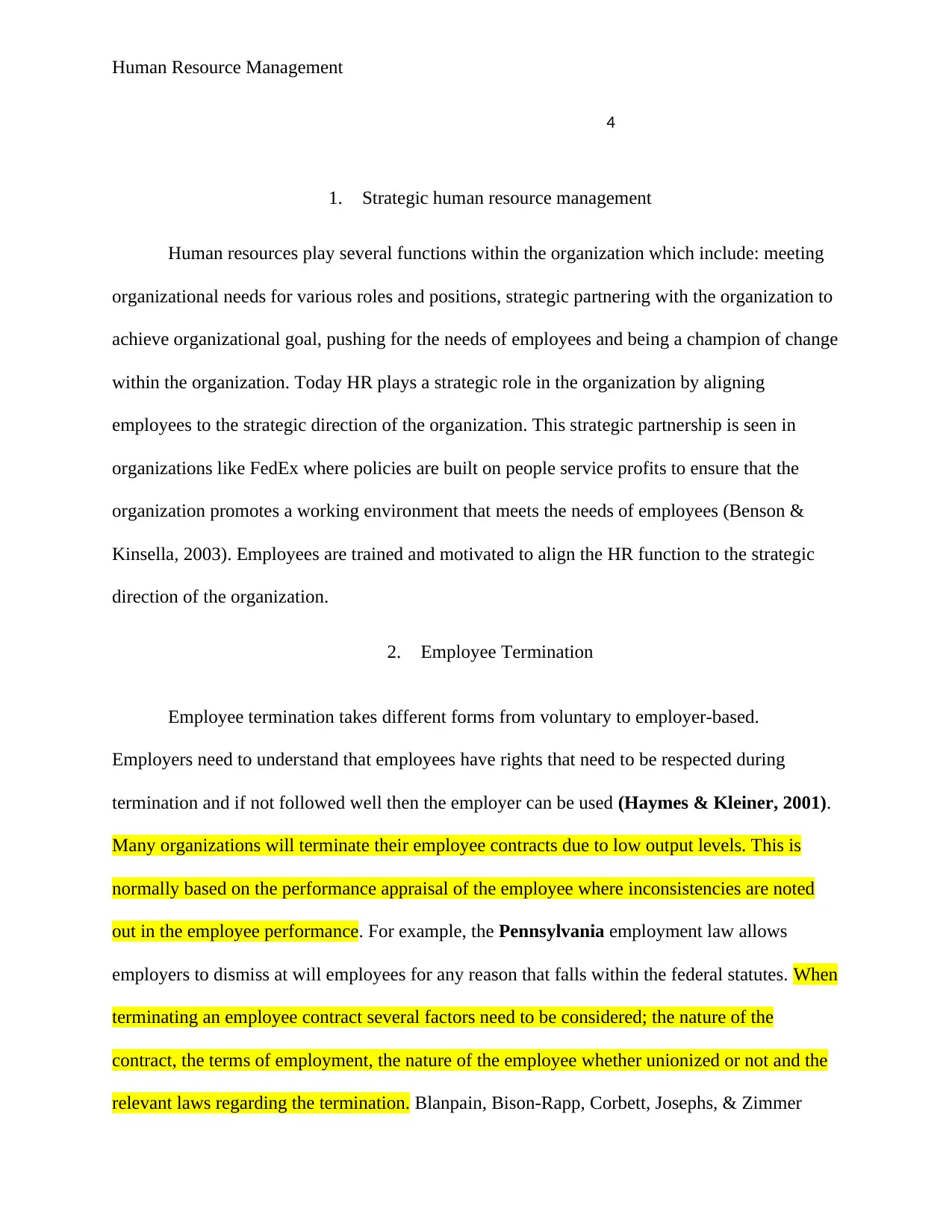
Human Resource Management
4
1. Strategic human resource management
Human resources play several functions within the organization which include: meeting
organizational needs for various roles and positions, strategic partnering with the organization to
achieve organizational goal, pushing for the needs of employees and being a champion of change
within the organization. Today HR plays a strategic role in the organization by aligning
employees to the strategic direction of the organization. This strategic partnership is seen in
organizations like FedEx where policies are built on people service profits to ensure that the
organization promotes a working environment that meets the needs of employees (Benson &
Kinsella, 2003). Employees are trained and motivated to align the HR function to the strategic
direction of the organization.
2. Employee Termination
Employee termination takes different forms from voluntary to employer-based.
Employers need to understand that employees have rights that need to be respected during
termination and if not followed well then the employer can be used (Haymes & Kleiner, 2001).
Many organizations will terminate their employee contracts due to low output levels. This is
normally based on the performance appraisal of the employee where inconsistencies are noted
out in the employee performance. For example, the Pennsylvania employment law allows
employers to dismiss at will employees for any reason that falls within the federal statutes. When
terminating an employee contract several factors need to be considered; the nature of the
contract, the terms of employment, the nature of the employee whether unionized or not and the
relevant laws regarding the termination. Blanpain, Bison-Rapp, Corbett, Josephs, & Zimmer
4
1. Strategic human resource management
Human resources play several functions within the organization which include: meeting
organizational needs for various roles and positions, strategic partnering with the organization to
achieve organizational goal, pushing for the needs of employees and being a champion of change
within the organization. Today HR plays a strategic role in the organization by aligning
employees to the strategic direction of the organization. This strategic partnership is seen in
organizations like FedEx where policies are built on people service profits to ensure that the
organization promotes a working environment that meets the needs of employees (Benson &
Kinsella, 2003). Employees are trained and motivated to align the HR function to the strategic
direction of the organization.
2. Employee Termination
Employee termination takes different forms from voluntary to employer-based.
Employers need to understand that employees have rights that need to be respected during
termination and if not followed well then the employer can be used (Haymes & Kleiner, 2001).
Many organizations will terminate their employee contracts due to low output levels. This is
normally based on the performance appraisal of the employee where inconsistencies are noted
out in the employee performance. For example, the Pennsylvania employment law allows
employers to dismiss at will employees for any reason that falls within the federal statutes. When
terminating an employee contract several factors need to be considered; the nature of the
contract, the terms of employment, the nature of the employee whether unionized or not and the
relevant laws regarding the termination. Blanpain, Bison-Rapp, Corbett, Josephs, & Zimmer
Paraphrase This Document
Need a fresh take? Get an instant paraphrase of this document with our AI Paraphraser
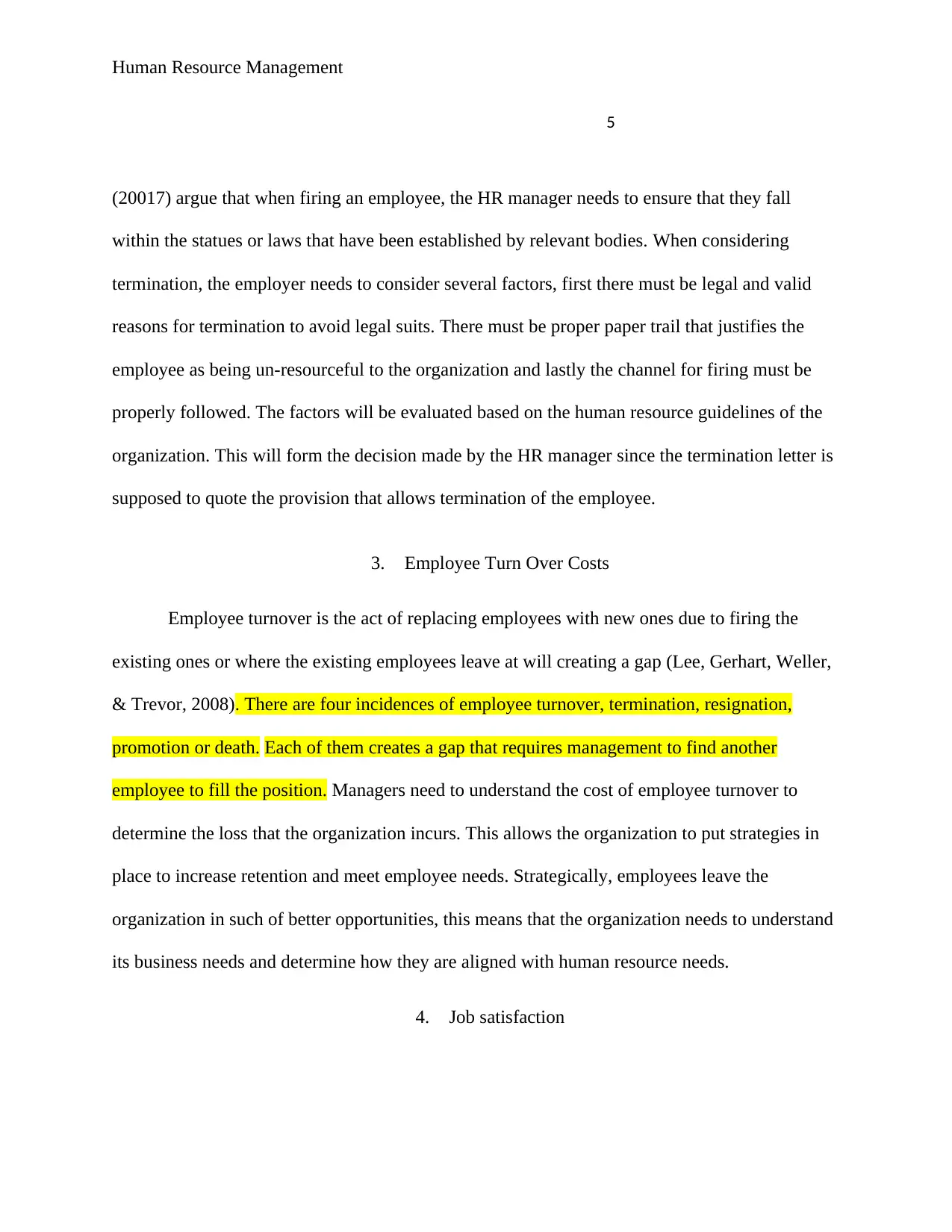
Human Resource Management
5
(20017) argue that when firing an employee, the HR manager needs to ensure that they fall
within the statues or laws that have been established by relevant bodies. When considering
termination, the employer needs to consider several factors, first there must be legal and valid
reasons for termination to avoid legal suits. There must be proper paper trail that justifies the
employee as being un-resourceful to the organization and lastly the channel for firing must be
properly followed. The factors will be evaluated based on the human resource guidelines of the
organization. This will form the decision made by the HR manager since the termination letter is
supposed to quote the provision that allows termination of the employee.
3. Employee Turn Over Costs
Employee turnover is the act of replacing employees with new ones due to firing the
existing ones or where the existing employees leave at will creating a gap (Lee, Gerhart, Weller,
& Trevor, 2008). There are four incidences of employee turnover, termination, resignation,
promotion or death. Each of them creates a gap that requires management to find another
employee to fill the position. Managers need to understand the cost of employee turnover to
determine the loss that the organization incurs. This allows the organization to put strategies in
place to increase retention and meet employee needs. Strategically, employees leave the
organization in such of better opportunities, this means that the organization needs to understand
its business needs and determine how they are aligned with human resource needs.
4. Job satisfaction
5
(20017) argue that when firing an employee, the HR manager needs to ensure that they fall
within the statues or laws that have been established by relevant bodies. When considering
termination, the employer needs to consider several factors, first there must be legal and valid
reasons for termination to avoid legal suits. There must be proper paper trail that justifies the
employee as being un-resourceful to the organization and lastly the channel for firing must be
properly followed. The factors will be evaluated based on the human resource guidelines of the
organization. This will form the decision made by the HR manager since the termination letter is
supposed to quote the provision that allows termination of the employee.
3. Employee Turn Over Costs
Employee turnover is the act of replacing employees with new ones due to firing the
existing ones or where the existing employees leave at will creating a gap (Lee, Gerhart, Weller,
& Trevor, 2008). There are four incidences of employee turnover, termination, resignation,
promotion or death. Each of them creates a gap that requires management to find another
employee to fill the position. Managers need to understand the cost of employee turnover to
determine the loss that the organization incurs. This allows the organization to put strategies in
place to increase retention and meet employee needs. Strategically, employees leave the
organization in such of better opportunities, this means that the organization needs to understand
its business needs and determine how they are aligned with human resource needs.
4. Job satisfaction
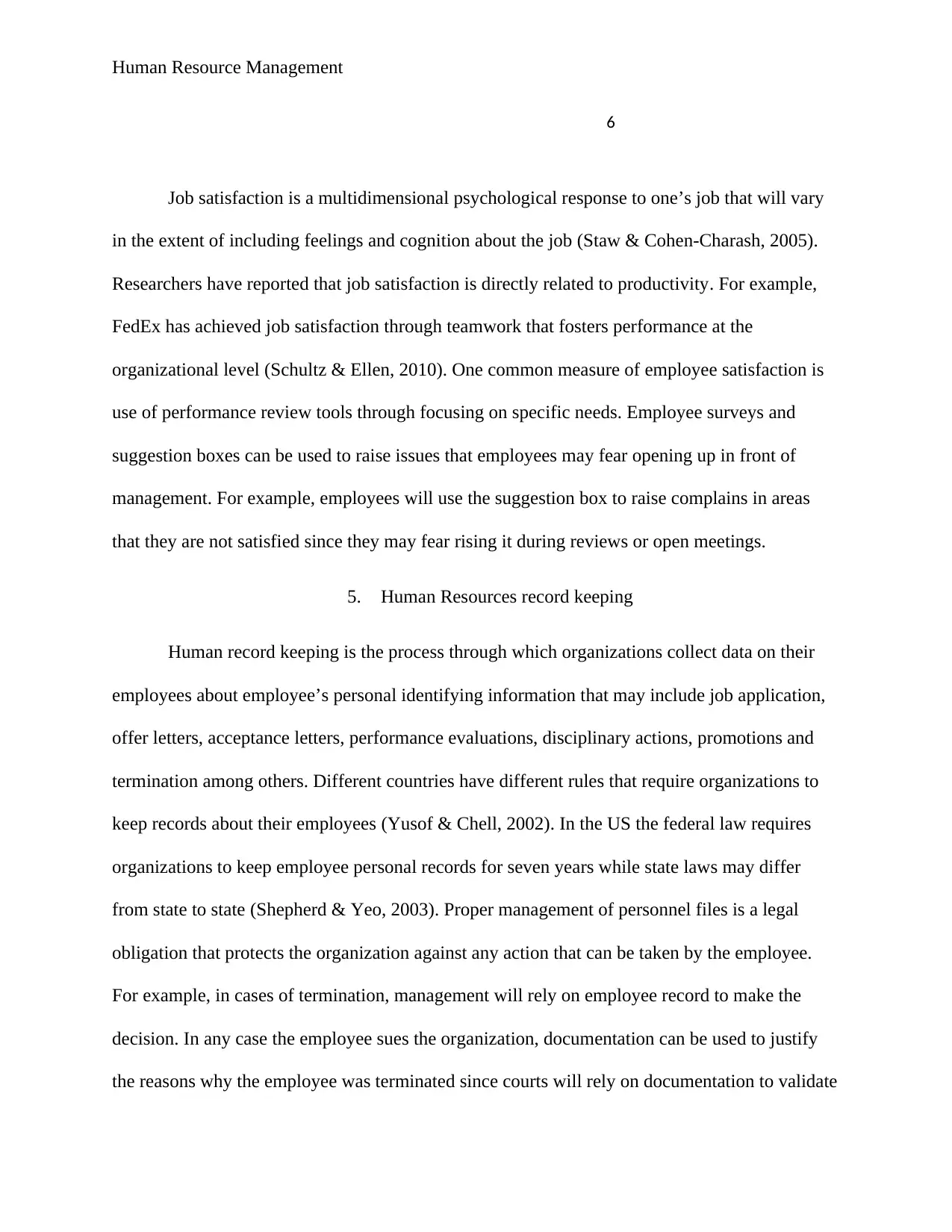
Human Resource Management
6
Job satisfaction is a multidimensional psychological response to one’s job that will vary
in the extent of including feelings and cognition about the job (Staw & Cohen-Charash, 2005).
Researchers have reported that job satisfaction is directly related to productivity. For example,
FedEx has achieved job satisfaction through teamwork that fosters performance at the
organizational level (Schultz & Ellen, 2010). One common measure of employee satisfaction is
use of performance review tools through focusing on specific needs. Employee surveys and
suggestion boxes can be used to raise issues that employees may fear opening up in front of
management. For example, employees will use the suggestion box to raise complains in areas
that they are not satisfied since they may fear rising it during reviews or open meetings.
5. Human Resources record keeping
Human record keeping is the process through which organizations collect data on their
employees about employee’s personal identifying information that may include job application,
offer letters, acceptance letters, performance evaluations, disciplinary actions, promotions and
termination among others. Different countries have different rules that require organizations to
keep records about their employees (Yusof & Chell, 2002). In the US the federal law requires
organizations to keep employee personal records for seven years while state laws may differ
from state to state (Shepherd & Yeo, 2003). Proper management of personnel files is a legal
obligation that protects the organization against any action that can be taken by the employee.
For example, in cases of termination, management will rely on employee record to make the
decision. In any case the employee sues the organization, documentation can be used to justify
the reasons why the employee was terminated since courts will rely on documentation to validate
6
Job satisfaction is a multidimensional psychological response to one’s job that will vary
in the extent of including feelings and cognition about the job (Staw & Cohen-Charash, 2005).
Researchers have reported that job satisfaction is directly related to productivity. For example,
FedEx has achieved job satisfaction through teamwork that fosters performance at the
organizational level (Schultz & Ellen, 2010). One common measure of employee satisfaction is
use of performance review tools through focusing on specific needs. Employee surveys and
suggestion boxes can be used to raise issues that employees may fear opening up in front of
management. For example, employees will use the suggestion box to raise complains in areas
that they are not satisfied since they may fear rising it during reviews or open meetings.
5. Human Resources record keeping
Human record keeping is the process through which organizations collect data on their
employees about employee’s personal identifying information that may include job application,
offer letters, acceptance letters, performance evaluations, disciplinary actions, promotions and
termination among others. Different countries have different rules that require organizations to
keep records about their employees (Yusof & Chell, 2002). In the US the federal law requires
organizations to keep employee personal records for seven years while state laws may differ
from state to state (Shepherd & Yeo, 2003). Proper management of personnel files is a legal
obligation that protects the organization against any action that can be taken by the employee.
For example, in cases of termination, management will rely on employee record to make the
decision. In any case the employee sues the organization, documentation can be used to justify
the reasons why the employee was terminated since courts will rely on documentation to validate
⊘ This is a preview!⊘
Do you want full access?
Subscribe today to unlock all pages.

Trusted by 1+ million students worldwide
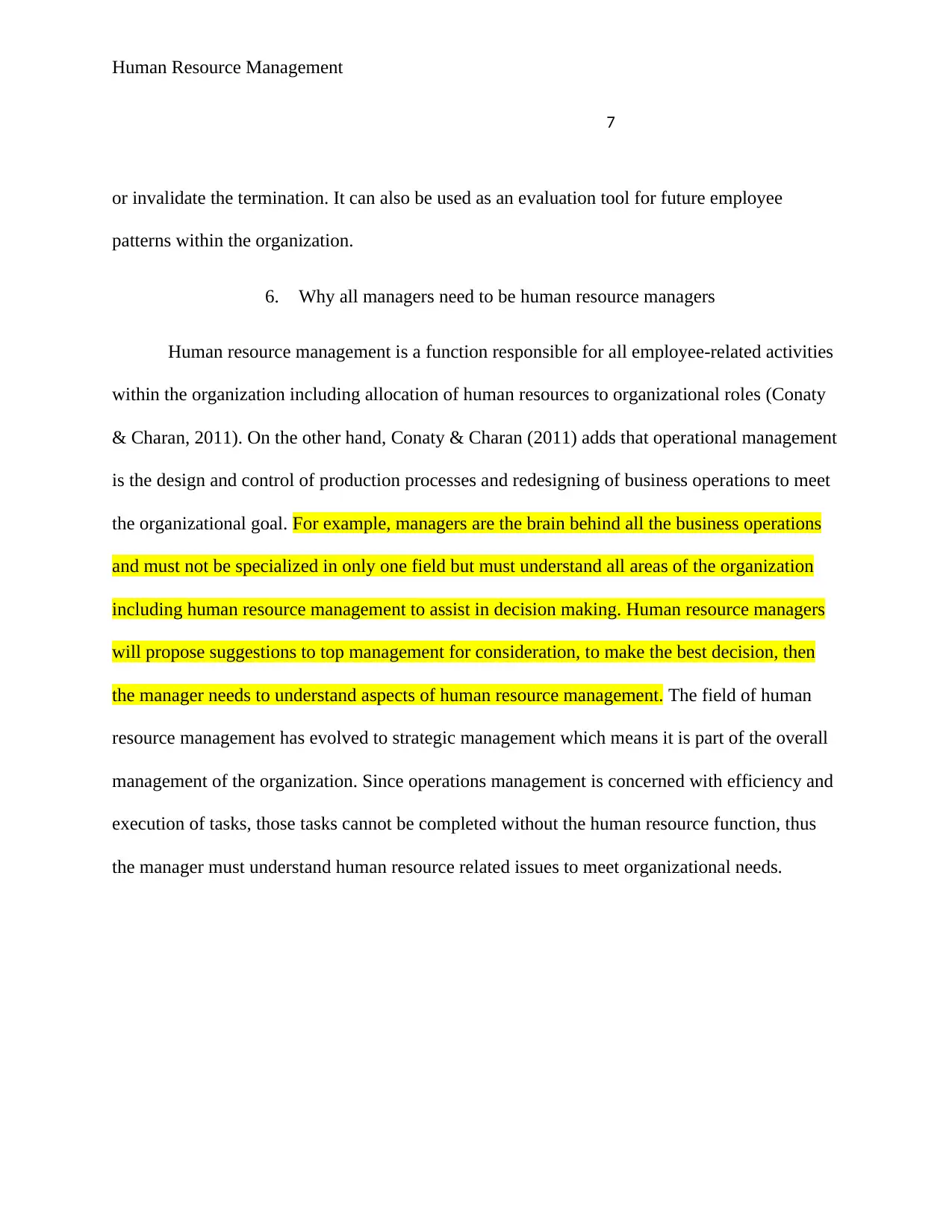
Human Resource Management
7
or invalidate the termination. It can also be used as an evaluation tool for future employee
patterns within the organization.
6. Why all managers need to be human resource managers
Human resource management is a function responsible for all employee-related activities
within the organization including allocation of human resources to organizational roles (Conaty
& Charan, 2011). On the other hand, Conaty & Charan (2011) adds that operational management
is the design and control of production processes and redesigning of business operations to meet
the organizational goal. For example, managers are the brain behind all the business operations
and must not be specialized in only one field but must understand all areas of the organization
including human resource management to assist in decision making. Human resource managers
will propose suggestions to top management for consideration, to make the best decision, then
the manager needs to understand aspects of human resource management. The field of human
resource management has evolved to strategic management which means it is part of the overall
management of the organization. Since operations management is concerned with efficiency and
execution of tasks, those tasks cannot be completed without the human resource function, thus
the manager must understand human resource related issues to meet organizational needs.
7
or invalidate the termination. It can also be used as an evaluation tool for future employee
patterns within the organization.
6. Why all managers need to be human resource managers
Human resource management is a function responsible for all employee-related activities
within the organization including allocation of human resources to organizational roles (Conaty
& Charan, 2011). On the other hand, Conaty & Charan (2011) adds that operational management
is the design and control of production processes and redesigning of business operations to meet
the organizational goal. For example, managers are the brain behind all the business operations
and must not be specialized in only one field but must understand all areas of the organization
including human resource management to assist in decision making. Human resource managers
will propose suggestions to top management for consideration, to make the best decision, then
the manager needs to understand aspects of human resource management. The field of human
resource management has evolved to strategic management which means it is part of the overall
management of the organization. Since operations management is concerned with efficiency and
execution of tasks, those tasks cannot be completed without the human resource function, thus
the manager must understand human resource related issues to meet organizational needs.
Paraphrase This Document
Need a fresh take? Get an instant paraphrase of this document with our AI Paraphraser
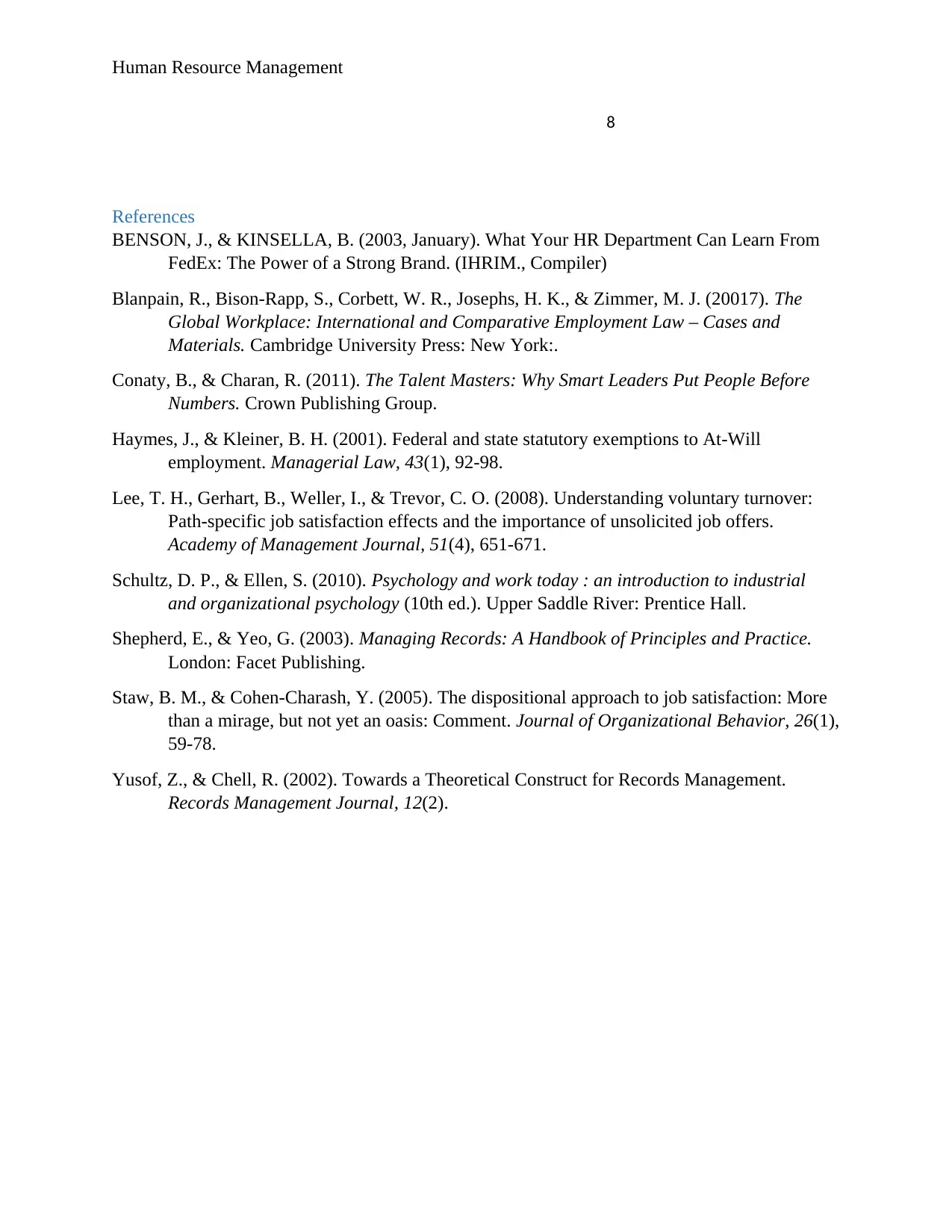
Human Resource Management
8
References
BENSON, J., & KINSELLA, B. (2003, January). What Your HR Department Can Learn From
FedEx: The Power of a Strong Brand. (IHRIM., Compiler)
Blanpain, R., Bison-Rapp, S., Corbett, W. R., Josephs, H. K., & Zimmer, M. J. (20017). The
Global Workplace: International and Comparative Employment Law – Cases and
Materials. Cambridge University Press: New York:.
Conaty, B., & Charan, R. (2011). The Talent Masters: Why Smart Leaders Put People Before
Numbers. Crown Publishing Group.
Haymes, J., & Kleiner, B. H. (2001). Federal and state statutory exemptions to At-Will
employment. Managerial Law, 43(1), 92-98.
Lee, T. H., Gerhart, B., Weller, I., & Trevor, C. O. (2008). Understanding voluntary turnover:
Path-specific job satisfaction effects and the importance of unsolicited job offers.
Academy of Management Journal, 51(4), 651-671.
Schultz, D. P., & Ellen, S. (2010). Psychology and work today : an introduction to industrial
and organizational psychology (10th ed.). Upper Saddle River: Prentice Hall.
Shepherd, E., & Yeo, G. (2003). Managing Records: A Handbook of Principles and Practice.
London: Facet Publishing.
Staw, B. M., & Cohen-Charash, Y. (2005). The dispositional approach to job satisfaction: More
than a mirage, but not yet an oasis: Comment. Journal of Organizational Behavior, 26(1),
59-78.
Yusof, Z., & Chell, R. (2002). Towards a Theoretical Construct for Records Management.
Records Management Journal, 12(2).
8
References
BENSON, J., & KINSELLA, B. (2003, January). What Your HR Department Can Learn From
FedEx: The Power of a Strong Brand. (IHRIM., Compiler)
Blanpain, R., Bison-Rapp, S., Corbett, W. R., Josephs, H. K., & Zimmer, M. J. (20017). The
Global Workplace: International and Comparative Employment Law – Cases and
Materials. Cambridge University Press: New York:.
Conaty, B., & Charan, R. (2011). The Talent Masters: Why Smart Leaders Put People Before
Numbers. Crown Publishing Group.
Haymes, J., & Kleiner, B. H. (2001). Federal and state statutory exemptions to At-Will
employment. Managerial Law, 43(1), 92-98.
Lee, T. H., Gerhart, B., Weller, I., & Trevor, C. O. (2008). Understanding voluntary turnover:
Path-specific job satisfaction effects and the importance of unsolicited job offers.
Academy of Management Journal, 51(4), 651-671.
Schultz, D. P., & Ellen, S. (2010). Psychology and work today : an introduction to industrial
and organizational psychology (10th ed.). Upper Saddle River: Prentice Hall.
Shepherd, E., & Yeo, G. (2003). Managing Records: A Handbook of Principles and Practice.
London: Facet Publishing.
Staw, B. M., & Cohen-Charash, Y. (2005). The dispositional approach to job satisfaction: More
than a mirage, but not yet an oasis: Comment. Journal of Organizational Behavior, 26(1),
59-78.
Yusof, Z., & Chell, R. (2002). Towards a Theoretical Construct for Records Management.
Records Management Journal, 12(2).
1 out of 8
Related Documents
Your All-in-One AI-Powered Toolkit for Academic Success.
+13062052269
info@desklib.com
Available 24*7 on WhatsApp / Email
![[object Object]](/_next/static/media/star-bottom.7253800d.svg)
Unlock your academic potential
Copyright © 2020–2025 A2Z Services. All Rights Reserved. Developed and managed by ZUCOL.




